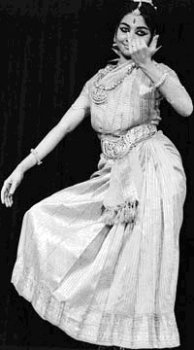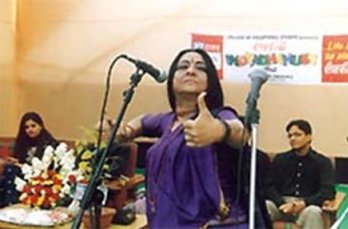
|
 |

|
 |
Yamini Krishnamurthy: The Prima Donna of Indian classical dance Exclusively on her Kuchipudi journey - Kuchipudi Vaibhavam e-mail: kuchipudi.vaibhavam@gmail.com July 18, 2010 (The interview is reproduced courtesy Kuchipudi Vaibhavam, an online blog dedicated to interviews, articles on history and theory of Kuchipudi etc) Where do we begin? How do we begin? Poets have lost their sleep over her, and Presidents have sat bedazzled through her performances. Her flashing arms, vivacious Abhinaya and innate mastery made each and everyone in countless audiences across the world gasp in wonder. Every movement was poetry in motion; every static pose was a sculptural masterpiece. A host of awards, a galaxy of glowing reviews, a bouquet of honors all pale before her passion and dedication to dance. As a pioneer in two Indian dance forms and as an exponent of another, the Asthana Narthaki of Kaliyuga Daivam Sri Tirumala Venkateswara, Indian Sangeet Natak Akademi Ratna, Padma Bhushan Yamini Krishnamurthy stands majestically in the Indian dance firmament. A free flowing interview with her marks the befittingly auspicious beginning of the Kuchipudi Vaibhavam interview series.  KV: As a leading artiste of Bharatanatyam at the time, what led to your initiation into Kuchipudi? YK: My initiation into Kuchipudi was totally the result of my master's encouragement. I was an established Bharatanatyam artiste even at the age of 21-22 in Chennai. Around the same time, Vedantham Laxminarayana Sastri was also a dance teacher in Chennai; he used to go to pupils' houses in a hand pulled rickshaw, taking lessons in various places. One day, he came to my place, and asked me why, being a Telugu girl, I was veering more towards Bharatanatyam and not imbibing the Telugu art form of Kuchipudi. Thus, I came into his tutelage, and one of the very first items I learnt was Dasavatara Shabdam! That's it! I was hooked! Kuchipudi's vivacious Abhinaya, the scope for spontaneity, the fast paced nritta, all suited my own nature. In fact, I was also very fortunate to have trained in Kuchipudi under the Trinity who shaped modern Kuchipudi: Vedantham Laxminarayana Sastri, Chinta Krishnamurthy, and Pasumarthy Venu Gopala Sarma! KV: How was your career progression in Kuchipudi? YK: That was the beginning of the 60s. In those days, Sangeet Natak Akademi conferences deemed only four Indian styles as classical dances, and Kuchipudi was not one of them. Owing to the profusion of dance masters who were Kuchipudi trained, Kuchipudi was termed as a "filmy dance" or Koothu. However, in the 1958 Natya Kala Conference under the leadership of Banda Kanakalingeswara Rao, Vissa Appa Rao and others, Kuchipudi was just beginning to get some amount of recognition. It was then that I burst on the scene. I toured all over India giving performances in various Andhra Mahasabhas and Telugu associations. I was the first to present Kuchipudi in London in a Commonwealth conference. I performed across Europe, Russia, America and many other countries. Pasumarthy Venu Gopala Sarma used to do nattuvangam and sometimes played the Sutradhari part in my performances! Wherever I went, the public adored my Kuchipudi performances. I also played Mohini in the Ksheera Sagara Madhanam ballet that was crafted by a young film dance master who had just returned to mainstream Kuchipudi dance. It was the first time that he himself was playing Vishnu. It was none other than Vempati Chinna Sathyam. I continued my tryst with Kuchipudi well into the twilight years of my performing career. KV: You are the only dancer to have had the unique distinction of having been presented with a "Bhama Veni" by the President of India. Tell us more about it.  YK: Dr. Sarvepalli Radhakrishnan was an outstanding man of erudition in many fields. He even knew many Kuchipudi songs! After my performance in Vempati's Ksheera Sagara Madhanam ballet, he gifted a "Bhama Veni" to me. I count this and the Asthana Narthaki position conferred on me by the Tirumala Tirupathi Devasthanam to be my two unique distinctions. All my accomplishments have been possible thanks to the training of my Gurus and my dance partners, and my support team. KV: Talking of support teams, your father was a very erudite scholar and your sister was an able vocal accompanist to your performances. They must have been very valuable assets to your career. YK: Indeed, I am very lucky to have the two of them. In those days, to let your daughter dance without marriage, touring countries etc. is no mean feat! My father, besides being a man of scholarly erudition in dance theory was always cognizant of my temperament and my passions. He was always my strength and stronger support pillar. He knew I could never get used to a life of regimentation and therefore withdrew me from Kalakshetra. Thus, I have had the good fortune of learning under all the Pillais: Guru Kittappa Pillai, Guru Elappa Pillai and others. Jyotishmati, my sister likewise, is a phenomenon in her own right. Her rendering of "Krishna Shabdam" made me very famous, and everywhere from Bombay to Delhi, all audiences were demanding encores! Without their support, I am not sure where I would have been!  KV: You have had a long and stellar career in dance; tell us one unforgettable moment from your Kuchipudi career. YK: There have been many such instances. However, I particularly recall one performance at the Rashtrapathi Bhavan in January 1971 in honor of the visiting Canadian Prime Minister Mr. Pierre Trudeau. Mrs. Gandhi was also present. I was about to conclude the 'Krishna Shabdam' I was performing, having reached the ending nritta part. However, Prime Minister Trudeau jumped onto the stage and started saying, "Don't Stop! Keep dancing, please!" I was shocked! And so was a disapproving Mrs. Gandhi! Another lighter moment I recall, was when in some performance of mine, I was enacting "Swamy Ra Ra" in the seated part of 'Krishna Shabdam' and an infatuated man thought I was calling him and came onto the stage! KV: As one of India's leading dancers you have always been subjected to the art critic's pen. How relevant do you think is the role of dance critics today, when information barriers are all but broken? YK: It is an inescapable fact that art critics are losing the importance they enjoyed before. Previously, a dance critic's review was the only way for lay rasikas to appreciate a dancer, and the verdict of a critic carried weight in determining the popularity of the dancer. Nowadays, dance criticism is more of an afterthought in newspapers than anything else. People are so aware, even young children can make if a dancer is maintaining aramandi or whether the soushtavam is correct or not. A barrage of dance information on net has made rasikas more informed. Indian dance scene is so changed, and in a way it is a loss for the dance critics. KV: What is your opinion on the present Kuchipudi art scene? YK: Kuchipudi's fundamental pillar has always been the quicksilver change of pace, the spontaneity and the sparkling dance. Today Kuchipudi is becoming stagnant. The vivacity is lost. If a young girl is dancing 'Krishna Shabdam' today, she has a fixed choreography that she is taught to strictly adhere to! We can predict with exact precision where she will look at which point in music, where she will pout and where she will glare. Everybody follows the same patterns set long ago. This is where Kuchipudi suffers, from the lack of innovation, especially in Abhinaya. As a dance drama form, a Kuchipudi dancer should imbibe that special element of "natakeeyatha" as we say in Telugu. A spontaneous dramatization, if you may. Without that Kuchipudi as it is danced today is more like Bharatanatyam. KV: Yamini School of Dance has produced outstanding talent like Rama Vaidyanathan in the field of Bharatanatyam. When can we expect to see similar talent in Kuchipudi from Yamini School of Dance? YK: For me, managing two art forms is difficult. Also, there are inherent difficulties in teaching Kuchipudi as compared to others. Thanks to Vachika Abhinaya, an understanding of Telugu and its nuances is compulsory in Kuchipudi, as compared to other dance forms. Besides the supporting staff I have here are specifically for Bharatanatyam. Even singing for a Kuchipudi recital as you know, is markedly different from the singing for a Bharatanatyam recital. I need more support staff to impart training in Kuchipudi. However, it is curious that you mention it at this point, as just two weeks back I was in Kuchipudi village. I am getting a mridangist from Kuchipudi apart from some other staff, so let us see what we can accomplish! KV: Last but not the least, do you see anyone from the present generation dedicating their life to dance as you did? YK: I don't think it's a straightforward "yes" or "no" answer. I believe I was chosen for this, my life played out its course, only for me to be a dancer always. It is destiny and as such I am most fortunate for it. But today's generation is so much more ambitious than mine. The search for future security is foremost in their minds. When I started dancing, I had no such worries. I never thought about the rainy day, and lived in the moment always. I suppose there is a special charm in living like that, but that may not be palatable to everyone. As such it becomes difficult for present day youngsters to commit themselves solely to dance. Whatever the reasons, my message to future dancers remains: "You must develop fierce dedication WITH detachment." It may sound paradoxical that you should not expect much from the art form, but give it your best. I know it takes a leap of faith to do so, but within that gap lies success. |